Did you know that indoor plants can reduce stress levels by up to 40% while purifying your air of harmful toxins? You don’t need a green thumb to transform your living space into a vibrant sanctuary; you just need the right placement strategy and plant selection. From creating dramatic living walls to crafting cozy herb gardens, these eight decoration techniques will help you maximize both the aesthetic and health benefits of indoor greenery. Let’s explore how to bring nature inside with purpose and style.
Contents
- 1 Create a Living Wall With Vertical Gardens
- 2 Design a Statement Plant Corner
- 3 Showcase Plants on Floating Shelves
- 4 Style Your Window Sills With Sun-Loving Species
- 5 Hang Trailing Plants From Macramé Holders
- 6 Arrange a Tabletop Terrarium Display
- 7 Transform Your Bathroom Into a Tropical Oasis
- 8 Build a Kitchen Herb Garden Station
Create a Living Wall With Vertical Gardens
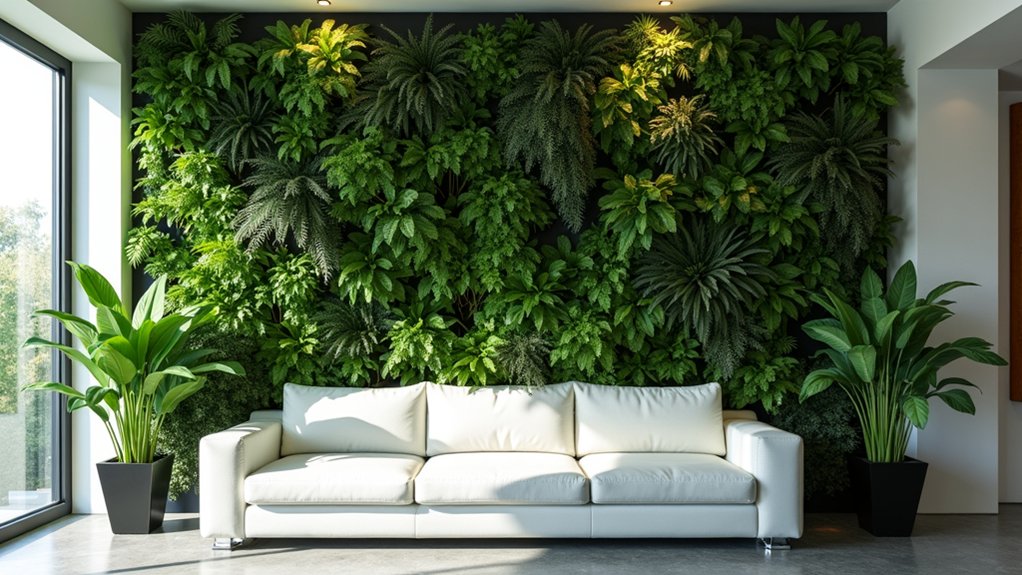
Living walls, also known as vertical gardens, transform ordinary indoor spaces into lush, three-dimensional landscapes by mounting plants on vertical surfaces. These striking installations can range from simple hanging planters to complex modular systems with built-in irrigation, creating a tapestry of foliage and colors that maximizes space while purifying indoor air.
Plants are typically arranged in patterns or flowing designs, incorporating various species with different textures, sizes, and hues.
- Light: Bright, indirect light is optimal; avoid direct sunlight which can scorch plants
- Water: Regular watering 2-3 times per week; moisture levels should be monitored with sensors in larger installations
- Soil: Well-draining potting mix specifically formulated for vertical gardens
- Humidity: 40-60% relative humidity
- Temperature: Consistent 65-80°F (18-27°C)
- Growing Medium: Can include traditional soil, hydroponics, or specialized foam substrates
- Support Structure: Must be mounted on moisture-resistant backing with proper waterproofing
Regular maintenance is crucial for vertical garden success and includes pruning dead or yellowing leaves, checking irrigation systems weekly, rotating plants if growth becomes uneven, and fertilizing monthly during growing season.
Inspect plants regularly for signs of pests or disease, as problems can spread quickly in the close-growing environment. Dust leaves monthly to maintain photosynthesis efficiency and replace any failing plants promptly to maintain the wall’s visual impact and structural integrity.
Design a Statement Plant Corner

Creating a statement plant corner transforms an empty indoor space into a lush, eye-catching focal point that draws attention and adds dramatic natural elements to your home. This design approach typically features a mix of plants at varying heights, combining large anchor plants like Fiddle Leaf Figs or Bird of Paradise with medium and smaller specimens arranged in layered groupings.
The corner setup often incorporates decorative stands, wall-mounted planters, or hanging baskets to create visual interest at multiple levels, while complementary pots and natural materials like woven baskets enhance the overall aesthetic.
Growing Conditions:
- Choose a corner with adequate natural light, ideally near windows facing east or south
- Maintain room temperature between 65-80°F (18-27°C)
- Group plants with similar humidity requirements together
- Ensure proper air circulation to prevent fungal issues
- Use well-draining potting mix appropriate for each plant type
- Place moisture-loving plants on humidity trays filled with pebbles and water
Regular grooming, rotation, and rearrangement keep a statement plant corner vibrant and healthy. Dust leaves monthly with a damp cloth to maintain photosynthesis efficiency and visual appeal.
Monitor each plant’s individual growth patterns and adjust their positions seasonally to ensure balanced growth. As plants grow or seasonal changes affect light conditions, be prepared to modify the arrangement, pruning overgrown specimens and replacing any declining plants to maintain the corner’s impact and harmony.
Showcase Plants on Floating Shelves
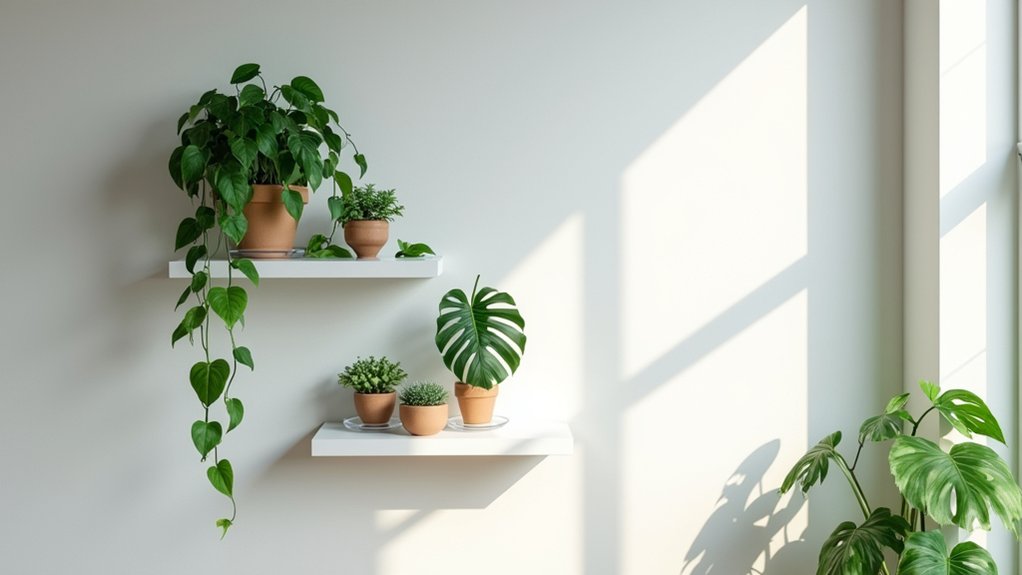
Floating shelves offer a sleek, modern way to display indoor plants while maximizing vertical space in any room. These wall-mounted platforms appear to “float” without visible brackets, creating an eye-catching architectural element that draws attention to your botanical collection.
When styled thoughtfully, floating shelves can accommodate plants of varying sizes, from trailing pothos to compact succulents, allowing you to create dynamic arrangements at different heights and depths.
- Mount shelves where plants will receive appropriate light based on individual species needs
- Choose sturdy shelves rated for the combined weight of pots, soil, and plants
- Ensure proper spacing between shelves for plant growth and maintenance access
- Install in areas with consistent temperatures (away from drafts and HVAC vents)
- Select shelf materials resistant to water damage and moisture
Regular maintenance of plants displayed on floating shelves requires strategic placement for easy access during watering and care routines.
Rotate plants quarterly to ensure even growth, as plants naturally grow toward light sources. Place saucers or water-resistant mats under pots to protect shelf surfaces, and dust both plants and shelves regularly to maintain a polished appearance.
When styling shelves, leave enough space between plants to allow for growth and proper air circulation, which helps prevent disease and pest issues.
Style Your Window Sills With Sun-Loving Species

Window sills offer prime real estate for sun-loving plants, creating a natural display that connects indoor spaces with the outside world.
Strategically placing light-hungry species along these sunny ledges not only maximizes their exposure to natural light but also creates an eye-catching green border that frames your views.
Consider arranging plants of varying heights, textures, and colors, with trailing varieties cascading down the sides and upright specimens providing vertical interest.
Growing Conditions:
- Direct sunlight for 4-6 hours daily, preferably morning sun
- Temperature between 65-80°F (18-27°C)
- Well-draining potting mix with added perlite
- Humidity levels between 40-60%
- Container depth of at least 6 inches with drainage holes
- Space between pots to allow air circulation
Regular grooming and rotation are essential for window sill plants to maintain their appearance and health.
Rotate pots quarter-turns weekly to ensure even growth, as plants naturally lean toward light sources.
Dust leaves monthly with a damp cloth to maximize light absorption and photosynthesis efficiency.
During winter months, move plants a few inches away from cold windows to protect them from drafts, and consider using humidity trays to offset the drying effects of nearby heating vents.
Hang Trailing Plants From Macramé Holders
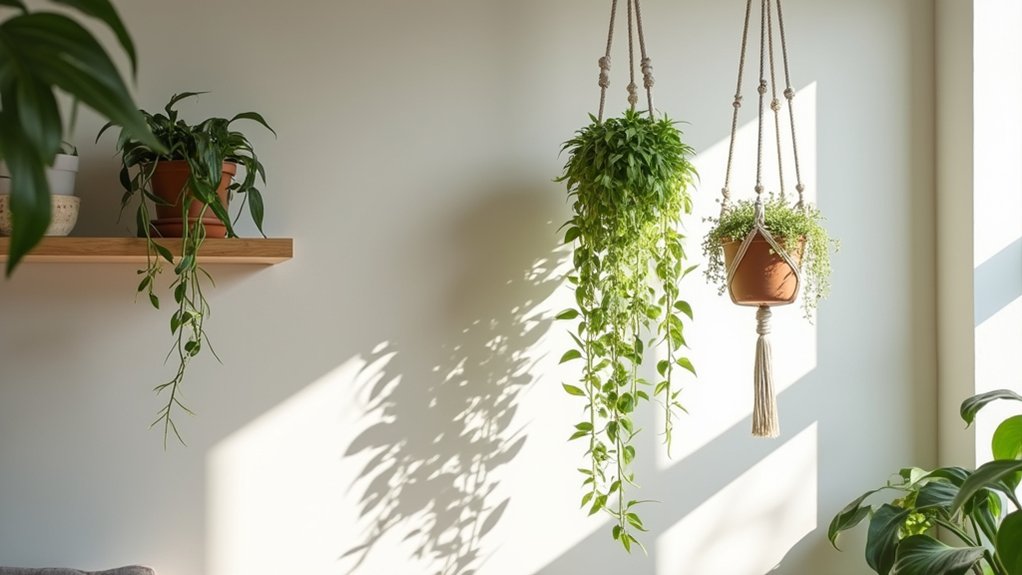
Macramé plant holders add a bohemian touch to indoor spaces while showcasing trailing plants in an elegant, suspended display. These woven holders, typically made from cotton or jute cord in intricate knotted patterns, cradle plastic or ceramic pots and can be hung from ceiling hooks, curtain rods, or wall brackets.
Popular trailing plants for macramé displays include pothos, string of pearls, spider plants, and philodendrons, whose cascading vines create a dramatic vertical garden effect.
Growing Conditions:
- Bright, indirect light works best for most trailing plants
- Ensure the hanging spot is away from heating/cooling vents
- Well-draining potting mix with added perlite
- Allow soil to dry slightly between waterings
- Maintain indoor temperatures between 65-80°F
- Moderate humidity levels (40-60%)
Regular maintenance of macramé-hung plants requires careful attention to prevent common issues. Check the knots and suspension points monthly to ensure they remain secure, as the weight of wet soil can strain the holders over time.
Rotate the plants quarterly to promote even growth, and trim leggy vines to maintain a fuller appearance. When watering, remove the plant from its hanging position to allow proper drainage and prevent water damage to floors or furniture below.
Clean the macramé cords occasionally with a gentle brush to remove dust and maintain their appearance.
Arrange a Tabletop Terrarium Display
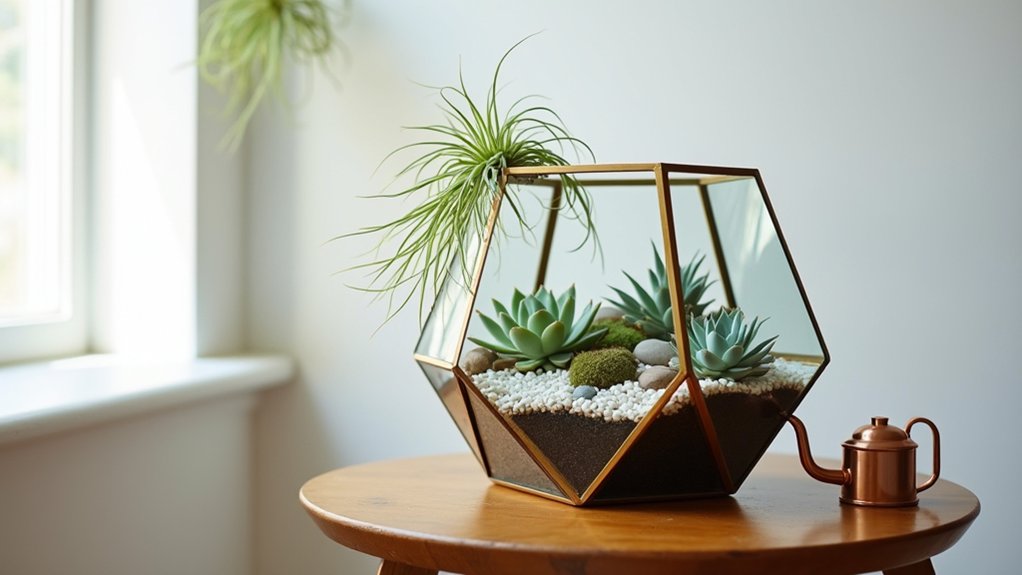
A tabletop terrarium display creates a miniature ecosystem within a clear glass container, featuring small plants arranged with decorative elements like stones, moss, and miniature figurines.
These self-contained gardens can showcase multiple plant varieties, from succulents to tropical specimens, layered with activated charcoal, soil, and drainage materials to create a visually striking focal point that brings nature indoors while requiring minimal space.
- Light: Bright, indirect sunlight; avoid direct sun which can create greenhouse effect
- Humidity: 40-60% for most terrarium plants
- Temperature: 65-80°F (18-27°C)
- Soil: Well-draining potting mix specific to plant type (succulent mix or tropical mix)
- Container: Clear glass with or without lid, depending on plant moisture needs
- Drainage: Layer of pebbles or gravel at bottom, followed by activated charcoal
- Depth: Minimum 4 inches of growing medium for proper root development
Regular maintenance ensures a healthy terrarium ecosystem by preventing overcrowding and maintaining proper moisture levels.
Trim plants when they touch the container walls, remove dead foliage promptly, and wipe the interior glass to prevent condensation buildup.
For open terrariums, check soil moisture weekly and water sparingly at the base of plants; closed terrariums typically need watering only every 4-6 months due to their self-sustaining nature.
Transform Your Bathroom Into a Tropical Oasis
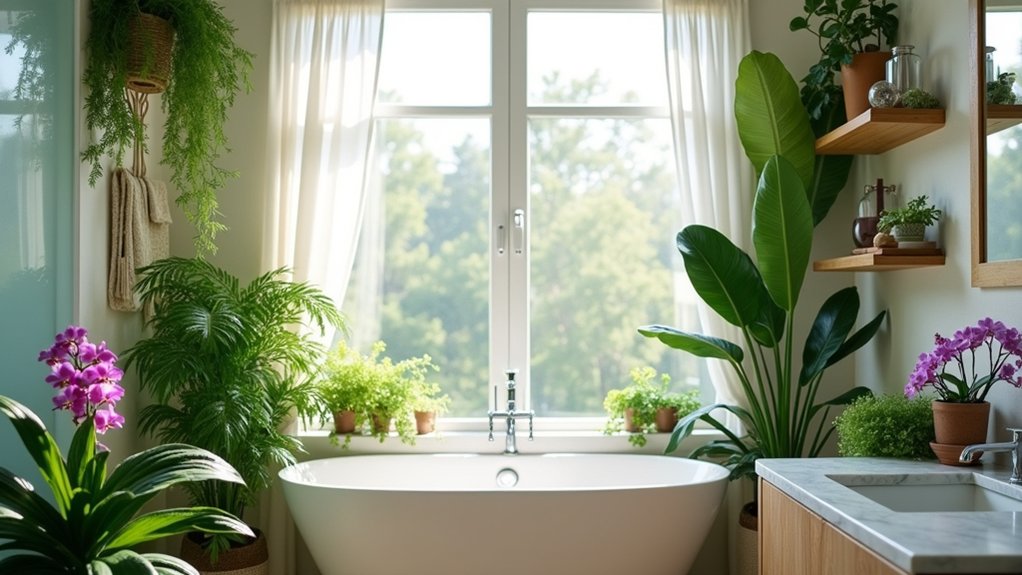
Transform your bathroom into a lush tropical retreat by strategically placing moisture-loving plants that thrive in humid environments. The combination of ferns, orchids, peace lilies, and snake plants creates layers of vibrant greenery at various heights, while hanging plants like pothos or air plants can cascade from shower rods or window frames.
This arrangement mimics a natural rainforest setting, utilizing the bathroom’s inherent moisture and creating a spa-like atmosphere.
Growing Conditions:
- High humidity levels (50-70%)
- Moderate to bright indirect light from bathroom windows
- Well-draining potting mix with added perlite for better aeration
- Temperatures between 65-80°F (18-27°C)
- Space between plants to allow proper air circulation
- Containers with drainage holes to prevent root rot
Regular maintenance involves weekly dusting of leaves to maintain their glossy appearance and ensure optimal photosynthesis, rotating plants quarterly for even growth, and inspecting for signs of pests that are attracted to humid environments.
Trim yellowing or dead foliage promptly to prevent fungal issues, and avoid overwatering despite the humid conditions, as standing water can lead to root problems.
Consider installing a small fan for air circulation if the bathroom lacks proper ventilation.
Build a Kitchen Herb Garden Station
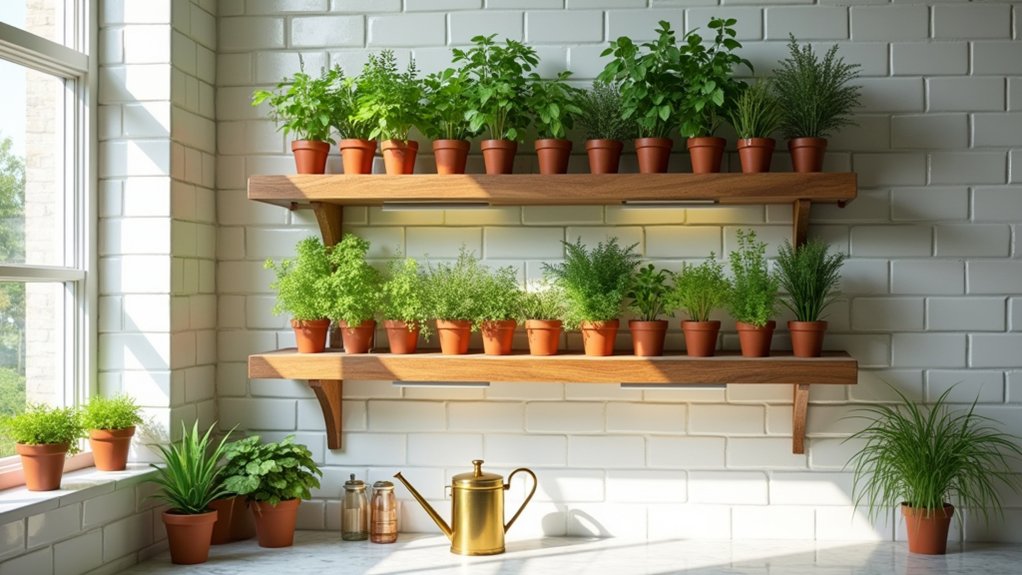
A kitchen herb garden station transforms an indoor kitchen space into a functional growing area that combines style with practicality. This compact gardening setup typically features tiered shelving, window-mounted planters, or vertical wall systems displaying an array of culinary herbs in coordinated containers.
The station can incorporate grow lights, drainage trays, and decorative elements like plant markers or vintage watering cans, creating both a practical growing space and an attractive kitchen focal point.
- Light: Minimum 6 hours of direct sunlight daily; south or west-facing windows ideal; supplemental grow lights recommended for darker locations
- Water: Consistent moisture with well-draining soil; water when top inch feels dry
- Soil: Well-aerated potting mix specifically formulated for herbs
- Temperature: 65-70°F (18-21°C)
- Humidity: Moderate humidity; avoid placing near AC vents
- Container: Pots with drainage holes, minimum 6 inches deep
- Spacing: 4-6 inches between plants to allow proper air circulation
Regular pruning encourages bushier growth and prevents herbs from becoming leggy or flowering prematurely.
Rotate containers weekly to ensure even growth, and fertilize with a balanced, water-soluble fertilizer every 4-6 weeks during the growing season.
Remove any yellowing or dead leaves promptly to prevent disease spread, and harvest herbs regularly to maintain plant vigor and promote continuous production.
